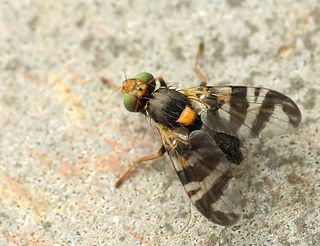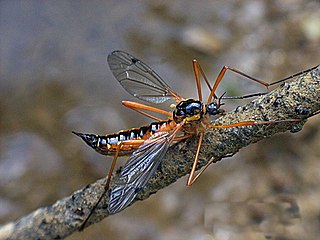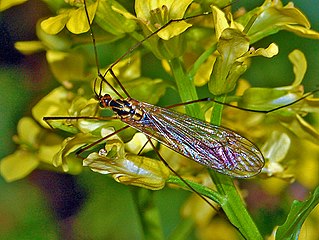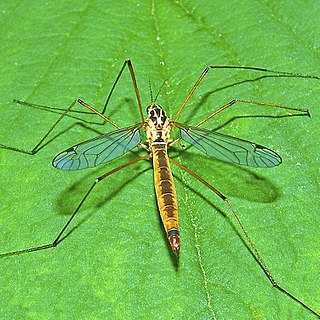
A crane fly is any member of the dipteran superfamily Tipuloidea, which contains the living families Cylindrotomidae, Limoniidae, Pediciidae and Tipulidae, as well as several extinct families. "Winter crane flies", members of the family Trichoceridae, are sufficiently different from the typical crane flies of Tipuloidea to be excluded from the superfamily Tipuloidea, and are placed as their sister group within Tipulomorpha.

Tipulidae is a family of large crane flies in the order Diptera. There are more than 30 genera and 4,200 described species in Tipulidae, common and widespread throughout the world.

The mint moth is a small moth from the family Crambidae, also known by the common name Small Purple and Gold.

Limoniidae is the largest of four crane fly families, with more than 10,700 species in more than 150 genera. Some studies have suggested it to be a paraphyletic group, with some limoniids being more closely related to Tipulidae and Cylindrotomidae than to other limoniids. Limoniid crane flies can usually be distinguished by the way the wings are held at rest. Limoniids usually hold/fold the wings along the back of the body, whereas other crane flies usually hold them out at right angles. Snow flies such as Chionea scita have no wings at all. Limoniids are also usually smaller than other crane flies, with some exceptions.

Rhagoletis cerasi is a species of fruit fly in the family Tephritidae.

Syritta pipiens, sometimes called the thick-legged hoverfly, is one of the most common species in the insect family Syrphidae. This fly originates from Europe and is currently distributed across Eurasia and North America. They are fast and nimble fliers, and their larvae are found in wet, rotting organic matter such as garden compost, manure, and silage. The species is also commonly found in human-created environments such as most farmland, gardens, and urban parks, wherever there are flowers. This species is an important part of its native ecosystem as adult Syritta pipiens flies are critical pollinators for a variety of flowering plants and the species supports parasitism by various parasitic wasp species. Thus, they play an important role in environmental functionality, and can serve as bio-indicators, in which their abundance can reflect the health of the environment. Syritta pipiens looks like many predatory hoverfly species, yet is not predatory.

Ctenophora is a genus of true crane flies. The species are large, shiny black craneflies with large yellow, orange, or red markings to mimic wasps. Males have comb-like antennae. The larvae are saproxylic. The species are confined to old deciduous forests, orchards, and other habitats with continuity of the presence of dying and fallen trees. Ctenophora species are important bioindicators.

Tipula is a very large insect genus in the fly family Tipulidae. The members of this genus are sometimes collectively called common crane flies. Tipula contains over 2,000 species located throughout the world.

Nephrotoma appendiculata, the spotted crane fly, is a species of crane fly.

Tipula paludosa is a species of true craneflies, family Tipulidae. It is also known as the European crane fly or the marsh crane fly. It is a pest in grasslands of Northwest Europe and has been accidentally introduced to North America.

Nephrotoma scurra is a species of crane fly found in most of Europe and the East Palearctic. It should not be confused with the crane fly Pselliophora scurraAlexander, 1941, from the subfamily Ctenophorinae.

Psila fimetaria is a species of fly, a member of the family Psilidae.

Limonia nubeculosa, also known as the short-palped cranefly, is a species of crane flies in the family of Limoniidae.

Nephrotoma flavescens is a species of fly in the family Tipulidae. It is found in the Palearctic.

Nephrotoma cornicina is a species of fly in the family Tipulidae.

Bibio hortulanus, common name marchfly, is a species of fly from the family Bibionidae.

Nephrotoma ferruginea is a species of large crane fly in the family Tipulidae.

Nephrotoma guestfalica is a species of crane fly within the family Tipulidae. It is present throughout the Palearctic and the species consists of multiple subspecies. Nephrotoma guestfalica has a preference for sandy soils, especially river banks.

Choerades marginata is a species of robber fly found in Europe.

Leptotarsus albistigma is a species of crane fly native to New Zealand. The species was first described as Macromastix albistigma by Frederick Wallace Edwards in 1923.




















